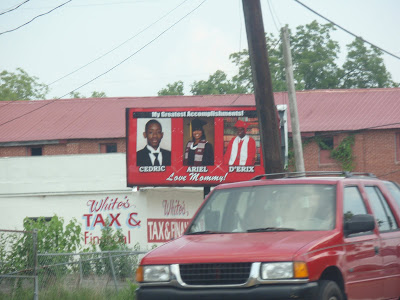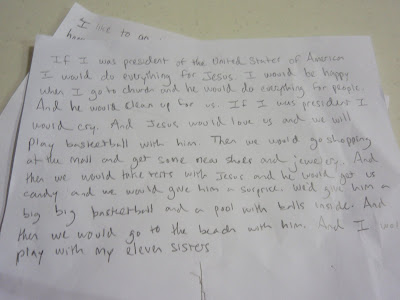Our last couple of weeks was filled with conducting surveys at sites, doing mop-up, and administering in-home sleep surveys. I was assigned to school sites mostly. We had to recruit in a ghost town, Van Lee Circle. Almost every housing unit looked like the following pictures.


I also administered my first sleep surveys during the last couple weeks. The study was designed to look at sleeping problems and habits of MYS participants, ages 14 to 15. The survey takes about 45 minutes to administer and we ask the participants a series of questions about their sleep habits, nightmares, depression, substance abuse, and chaos in the home environment. This data will then be matched to the MYS data to see if any attitudes, experiences and behaviors may predict or be associated with poor sleep outcomes. In theory it sounds like a fascinating study but it was extremely difficult to read and very repetitive. The kids also only received five dollars, which they were not too excited about. Our goal was to administer 150 surveys throughout the summer, which doesn't sound like a lot but it was very difficult to reach.
My partner and I headed to R V Taylor to recruit and administer sleep surveys. We finally found a girl that had time to take it. We usually split up reading the in-home surveys, so the partner not reading doesn't get too bored. My partner began reading the survey and I started chatting with the participant's mother, Charlotte. Charlotte had lived in R V Taylor since she was a small girl. She had a hard life with men and drugs. She never actually said this to me but kept saying that the "devil had tempted her to do some bad things in her life". Her boyfriend had a lot of trouble with drugs, so assumed she was mixed up in it as well. However, when she became pregnant at around 16 (she couldn't quite remember), she knew she had to change her life. She found God. We talked a lot about her church community and how the father of her child decided to move in with her. They were going to make a life for themselves. She had four children with this man and they are still living together.
She was extremely proud of the fact that her man (not sure if they were married or not) had stuck with her through all her pregnancies. She felt very blessed that God had given her such a reliable partner. I chose this word "reliable" carefully because she was not referring to having a loving partner, she was happy with him because he had stuck around. She then said how blessed she was to have her four children and that she was happy not to be having anymore because she was grandma now. A little infant was resting on her chest the whole time we were having this conversation; it was her baby granddaughter. Her daughter had unexpectedly become pregnant.
Two very interesting conversation stemmed from this. First, we discussed birth control, and then we discussed men's lack of involvement in family planning and how the burden lay entirely on the woman. Charlotte got pregnant young and she was not in denial about her girls becoming sexually active at an early age. While she tried to tell them to wait, she knew how the neighborhood worked and that this is what young people did. She brought her 15 year-old daughter to the doctor to get her on birth control. Many of the girls in the community had trouble complying with taking a pill everyday, so the doctor was promoting the birth control patch. Charlotte was so upset talking about how much trouble her daughter had with this form of birth control. It was constantly falling off and her daughter sometimes forgot to change it. However, Charlotte did not know what to do about this. She did not go back to the doctor to try and get another form. She just accepted the patch as the only form of birth control for her daughter. Low and behold, her daughter got pregnant and her beautiful granddaughter was born.
I was so disheartened by this story. Here was a woman that had done everything right for her daughter. She had accessed family planning services for her daughter and the system had failed her. I was also upset with this physician. I was trained in family planning education, and the fact that Charlotte had heard that the patch was her daughter's only option was very upsetting. Later, my partner and I speculated that this could be because it is a cheap form of birth control and something it alleviates the burden of taking a pill everyday. But more options should have been shared with Charlotte and her daughter.
Charlotte then turned her focus to her 14 year-old daughter that we were surveying. She asked me about birth control options for her. I told her about all the options I could think of and referred her to Planned Parenthood's website that explains all these options. I stressed that there were options and what works for one person, doesn't necessarily work for another. She was so happy to have someone talk to her frankly about birth control and she thanked me for not judging her. I told her I would never judge a mother that advocated for the health of her daughters and that I wished more mothers were involved with their daughters' lives.
Our conversation then took a turn to male involvement in birth control. She explained that men just refused to wear condoms and that was the way it was. I had heard this from many other mothers. She said she was glad she was done with pregnancy; she had gotten her tubes tided. I asked her if she had asked her partner if he would get a vasectomy because it is a simpler procedure. She just laughed at me. She said, "Honey, that's what white men do. They have their little ladies tellin' them what to do and they do it. A black man wouldn't be caught dead doin' that." I asked her why she thought that was, and she said because black men never stay put. They may leave their woman and they need to be able to have kids with their new woman.
Again, this was hard for me process. This culture of hypermasculinity astounds me! It was very similar to what I heard in India. Being "male" is very much connected to potency or the ability to have many children. I just wonder how this gets taught to young men in the community. Why don't they fear getting someone pregnant? Why don't they want to use condoms? Why don't their mothers, who are very involved in their daughters' sexual health, have these conversations with their sons? In India, a male troupe set-out to do puppet street performances targeted to men. They wanted to tap into masculinity, by claiming that the "manly" thing to do is to take care of their family and this means protecting their women and children from diseases by wearing condoms. I am very curious how condom use and negotiation is discussed in these neighborhoods. According to the women I talked to, condom negotiation appears to be nonexistent. They simply say that boys refuse to wear them, so the girls must take birth control. But what does this mean for sexually transmitted infections, such as HIV. Every kid we surveyed said they were scared of AIDS... but how do they protect themselves from HIV, if they are not using barrier methods? It is a very scary reality!
I learned a lot from Charlotte and it made me more curious about this masculine culture surrounding pregnancy. It is a reality that is so different from how I grew-up, a practice and mindset that I had equated with cultures outside of the United States. Again, I was surprised to find it here in the United States. However, it is also uniquely American, a culture of teen pregnancy complicated by a cyclical pattern of adolescent pregnancy that is rooted in poverty, historical racism and strict binary gender dynamics.




































